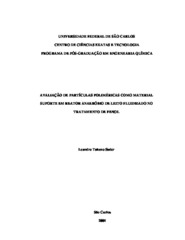Mostrar el registro sencillo del ítem
Avaliação de partículas poliméricas como material suporte em reator anaeróbio de leito fluidizado no tratamento de fenol.
| dc.contributor.author | Sader, Leandro Takano | |
| dc.date.accessioned | 2016-06-02T19:56:56Z | |
| dc.date.available | 2005-06-16 | |
| dc.date.available | 2016-06-02T19:56:56Z | |
| dc.date.issued | 2005-03-24 | |
| dc.identifier.citation | SADER, Leandro Takano. Avaliação de partículas poliméricas como material suporte em reator anaeróbio de leito fluidizado no tratamento de fenol.. 2005. 158 f. Dissertação (Mestrado em Ciências Exatas e da Terra) - Universidade Federal de São Carlos, São Carlos, 2005. | por |
| dc.identifier.uri | https://repositorio.ufscar.br/handle/ufscar/4149 | |
| dc.description.abstract | This work had as objective studies of the biofilms formation in polymerics particles used as material supports in anaerobic fluidized-bed reactors. Three polymerics supports were tested: polystyrene, PET and PVC, which suffered appropriate acid treatment, in way to provide them superficial characteristics as rugosity, porosity and favorable electric charge, with the purpose of favoring the microbial adhesion. The reactors were inoculated with sludge originating from reactor UASB that treated swine slaughterhouse residue, adapted to the degradation of the phenol by 150 days. The volume of the reactors was of 770cm3, and they operated with ascendant speed of 1,3 times of the flow rate of the minimum fluidization. The phenol concentration varied from 100 to 400mg/L in the feeding of each system, presenting results of removal of phenol of 97%, 98% and 97,5% and removal of DQO of 84%, 88,5% and 87%, respectively for the reactors with polystyrene, PET and PVC, which operated with time of detention hydraulic relative the height of the bed, corresponding to the reactional volume of the reactors (TDHr) of 22 h, 10,6 h and 20,4 h, respectively. The quantification of extracellular polymeric showed better results for the particles of PVC that it presented 0,2 mgCarbohydrate/gParticle and 0,06 mgProteyn/gParticle. However, deformations in those particles harming the acting of the reactor, defining as better support the particles of PET, and in this reactor the percentage of phenol removal was larger for a smaller TDHr. | eng |
| dc.description.sponsorship | Universidade Federal de Minas Gerais | |
| dc.format | application/pdf | por |
| dc.language | por | por |
| dc.publisher | Universidade Federal de São Carlos | por |
| dc.rights | Acesso Aberto | por |
| dc.subject | Biotecnologia | por |
| dc.subject | Processo anaeróbio | por |
| dc.subject | Leito fluidizado | por |
| dc.subject | Fenol | por |
| dc.subject | Biofilme | por |
| dc.subject | Process anaeróbio | eng |
| dc.subject | Fluidized bed | eng |
| dc.subject | Phenol and biofilm | eng |
| dc.title | Avaliação de partículas poliméricas como material suporte em reator anaeróbio de leito fluidizado no tratamento de fenol. | por |
| dc.type | Dissertação | por |
| dc.contributor.advisor1 | Silva, Edson Luiz | |
| dc.contributor.advisor1Lattes | http://genos.cnpq.br:12010/dwlattes/owa/prc_imp_cv_int?f_cod=K4791192Y4 | por |
| dc.description.resumo | Este trabalho teve como objetivo estudar da formação de biofilmes em partículas poliméricas usadas como meio suporte em reatores anaeróbios de leito fluidizado. Foram testados 3 suportes poliméricos: poliestireno, PET e PVC, os quais sofreram tratamento ácido adequado, de modo a proporcionar-lhes características superficiais como rugosidade, porosidade e carga elétrica favorável, com a finalidade de favorecer a adesão microbiana. Os reatores foram inoculados com lodo proveniente de reator UASB que tratava resíduo de suinocultura, adaptado à degradação do fenol por 150 dias. O volume dos reatores era de 770cm3, e operaram com velocidade ascensional igual a 1,3 vezes da vazão de mínima fluidização. A concentração de fenol variou de 100 a 400mg/L na alimentação de cada sistema, apresentando resultados de remoção de fenol de 97%, 98% e 97,5% e remoção de DQO de 84%, 88,5% e 87%, respectivamente para os reatores com poliestireno, PET e PVC, os quais operaram com tempo de detenção hidráulico relativo a altura do leito, correspondente ao volume reacional dos reatores (TDHr) de 22 h, 10,6 h e 20,4h, respectivamente. A quantificação de polímeros extracelulares mostrou melhores resultados para as partículas de PVC que apresentou 0,2 mgCarboidrato/gPartícula e 0,06 mgProteina/gPartícula. No entanto, deformações nessas partículas prejudicaram o desempenho do reator, definindo como melhor suporte as partículas de PET, sendo que neste reator a porcentagem de remoção de fenol foi maior para um menor TDHr. | por |
| dc.publisher.country | BR | por |
| dc.publisher.initials | UFSCar | por |
| dc.publisher.program | Programa de Pós-Graduação em Engenharia Química - PPGEQ | por |
| dc.subject.cnpq | ENGENHARIAS::ENGENHARIA QUIMICA | por |
| dc.contributor.authorlattes | http://buscatextual.cnpq.br/buscatextual/visualizacv.do?id=K4764930E3 | por |
